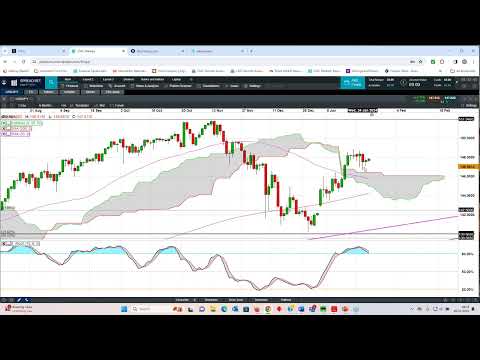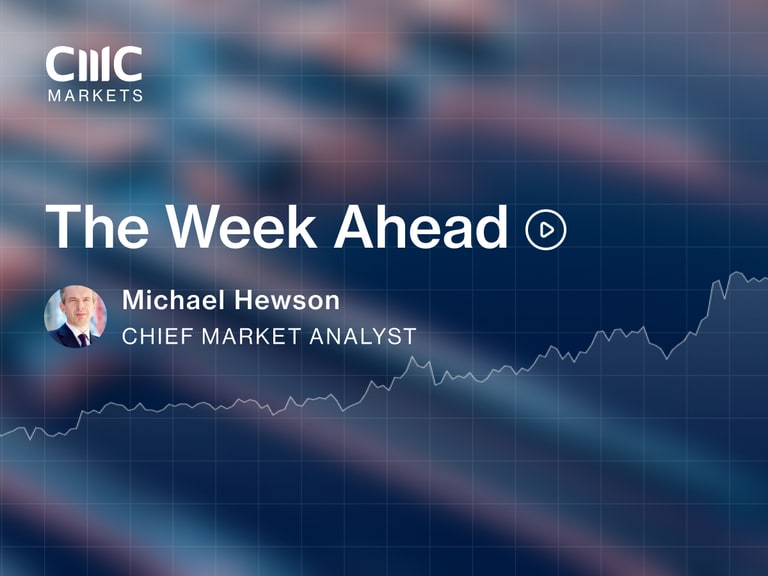Here’s our pick of the top three economic and company events in the week commencing Monday, 29 January 2024:
Microsoft Q2 results
Tuesday 30 January: Shares of Microsoft – whose Q2 results kick off a busy week of tech earnings – have gone from strength to strength in recent months. The stock gained roughly 60% last year, helping Microsoft to become the most valuable company in the world on 11 January as its stock market valuation briefly overtook that of Apple. The two tech giants remain neck and neck in the scrap for the most-valuable-company tag, each with valuations a shade under $3tn. Microsoft’s Q1 revenue came in at $56.5bn, up 13% year-on-year, comfortably beating forecasts of $54.5bn. Profit rose 27% to $2.99 a share. Revenue from cloud computing division Azure and other services increased 29%, above forecasts of 25% to 26%, while revenue from personal computing rose 3% to $13.7bn, helped by a 5% increase in Windows revenue. Xbox content and services revenue was up 13%, although devices revenue fell 22%. Investment in AI is a key area for traders to watch as Microsoft develops solutions for business and integrates its Copilot chatbot into the Windows operating system. Analyst estimates for Q2 suggest that revenue surged by almost 20% to $61.1bn, with commercial cloud revenue set to account for $32.2bn of that total. Profit is forecast to come in at $2.77 a share.
US Federal Reserve interest rate decision
Wednesday 31 January: While the Federal Reserve is this week expected to hold its benchmark interest rate at a target range of 5.25% to 5.5%, the focus among traders will be on the timetable for rate cuts. Markets are betting that the first cut could come in March – after this week, the next rate-setting Federal Open Market Committee meeting is scheduled for 19-20 March. This may be too soon for some FOMC members, despite the core personal consumption expenditures index having eased to 3.2% in the year to November. Unlike US stock markets, which have risen to all-time highs on expectations of imminent rate cuts, bond markets appear to be taking a more cautious view of when rates could be cut. While the five-year yield has finally managed to sustain a fall below the 10-year yield, the two-year yield has remained inverted. If the Fed is minded to deliver a rate cut in March, then this Wednesday offers the perfect opportunity to signal its intention. If, however, policymakers are looking at holding rates at current levels beyond March, it might be best to curb the markets’ enthusiasm.
Bank of England interest rate decision
Thursday 1 February: In December the Bank of England’s Monetary Policy Committee voted 6-3 to keep the base rate at 5.25%, where it is likely to remain when the MPC meets on Thursday. Three external members of the nine-person MPC – Catherine Mann, Megan Greene and Jonathan Haskel – voted to raise interest rates by a quarter of a percentage point over concerns about inflation, which was running at 4% in December, up from 3.9% in November. Service-sector inflation was at 6.1% in December, while pay excluding bonuses grew 6.6% in the three months to November. Following last month’s rate hold and a larger-than-expected 3.2% month-on-month decline in retail sales in December, market expectations of an imminent rate cut have grown. However, BoE governor Andrew Bailey said in December that there was “still some way to go” in the fight against inflation. That’s why no change is expected to monetary policy in February, though it will be interesting to find out whether Mann, Greene and Haskel vote with the rest to hold rates. As for the prospect of rate cuts this year, it’s now a question of when, not if, rates will be cut.
Here's our pick of the week's other notable economic and company events:
Germany Q4 GDP
Tue 30 Jan: With inflation coming down sharply over the last 12 months, there have been calls for the ECB to signal it is prepared to cut rates soon. That could help boost Germany’s manufacturing sector, which has been in recession for more than a year. The country’s services sector has also been struggling. No wonder, then, that Germany’s economy shrank by 0.8% last year. The Q4 GDP reading is expected to show a minor contraction, similar to the 0.1% decline that was recorded in Q3.
Alphabet Q4 results
Tue 30 Jan: Shares of Google owner Alphabet last year gained more than 55%, reversing the decline of 2022. The momentum has continued into this year, too, with the shares touching a record intraday high of $154.76 on 25 January. After the Q3 numbers came out, the shares briefly fell to three-month lows before rebounding. Not that there was much to dislike about the Q3 results. One minor blip was a miss on cloud revenue, which came in at $8.4bn, slightly below forecasts of $8.6bn, but still well above last year’s $6.87bn. On all other metrics the results were strong. Revenue increased 11% to $76.7bn, and profit came in at $19.69bn, or $1.55 a share. There were comfortable revenue beats across the business. YouTube chipped in $7.95bn, advertising delivered a whopping $59.65bn, and other revenue amounted to $8.34bn. That took total services revenue to $67.99bn. For Q4, revenue is expected to come in at $85.3bn, with the cloud division expected to contribute $8.95bn. Profit is forecast to be worth $1.59 a share.
Eurozone flash CPI (January)
Thu 1 Feb: Last month several ECB policymakers pushed back on market expectations of an early interest rate cut. The most vehement opposition to lower rates came from hawks Joachim Nagel of the German Bundesbank and Robert Holzmann of the Austrian central bank. Other governing council members were more amenable to the idea that a rate cut could come as early as the summer, with ECB president Christine Lagarde suggesting that a move in June might be appropriate if the data supported it. However, the case for a cut was undermined somewhat by an uptick in inflation in December as headline CPI jumped to 2.9%, up from 2.4% in November. That said, core inflation continued to ease, slowing to 3.4% in December, down from 3.6% a month earlier. A further easing of inflationary pressures on the back of lower energy prices are likely to add to calls for an early rate cut, despite official statements at this month’s ECB meeting that rates will stay where they are for now.
BT Group Q3 results
Thu 1 Feb: Investor sentiment towards the BT share price has been lukewarm over the past year. After hitting one-year lows of around 110p in October, the shares spiked to six-month highs in December on the back of positive Q2 results, before optimism faded and the stock fell back to current levels around 116p. The half-year numbers showed that BT had made progress on its goal to improve margins as the company raised its guidance on full-year cash flow to the upper end of its £1bn to £1.2bn guidance. Half-year revenue came in at £10.4bn, while reported profit before tax rose 29% to £1.1bn. The Openreach business appears to be performing strongly, adding 364,000 customers in Q2 and increasing average revenue per user (ARPU) by 10% year-on-year. Consumer broadband also saw a 4% increase in ARPU. An interim dividend of 2.31p per share was in line with expectations.
Shell full-year results
Thu 1 Feb: Since hitting a record high in October, the Shell share price has pulled back 10% amid falling oil and gas prices. A few weeks ago, Shell said it expected the Q4 and full-year results to show a much better performance from its gas trading business. However, any uplift here is likely to be offset by weakness in its chemicals business, which reported a loss of $468m in Q2. After the record revenues and profits of the previous year, 2023 was arguably always likely to mark a slowdown, even after accounting for improvements in refining margins. In Q3 Shell reported a profit of $6.22bn, in line with market expectations, and announced plans to increase its share buyback to $3.5bn. Profit from the integrated gas business remained steady and in line with Q2 at $2.5bn, while upstream profits came in at $2.22bn, a significant fall from the year-ago quarter. Shell’s chemicals and products division fared better in Q3, returning to a profit of $1.38bn. The pivot, announced by CEO Wael Sarwan last summer, towards a focus on returns and investment in “the models that work” and “those with the highest returns” heralded a change in the company’s attitude towards renewables, with the company saying that the shift to clean energy is likely to be more gradual due to surging costs. Shell’s renewables business sank to a loss of $67m in Q3 as margins tightened and operating expenses increased. As for Q4, profit is forecast to come in at $6.2bn, with integrated gas expected to account for $3.2bn and upstream $2.4bn. Traders’ focus is likely to be on margins as shipping costs spiked during the quarter due to events in the Red Sea. On an annual basis, full-year profit is forecast to fall to $27.4bn, down from the previous year’s record $39.87bn.
Meta Platforms Q4 results
Thu 1 Feb: Shares of Facebook parent company Meta rose almost 200% last year, erasing the declines of 2022. The shares posted a new record high of $396.15 on 24 January, despite there being little prospect that its Reality Labs division will turn a profit any time soon. In Q3 Meta reported revenue of $34.15bn, at the top end of forecasts, while profit came in at $11.58bn, or $4.63c a share. Revenue guidance for Q4 was nudged up to between $36.5bn and $40bn, although this was tempered by a warning that ad revenue might slow due to uncertainty around the global economy. Full-year operating expenses were revised lower to between $87bn and $89bn, while full-year revenue is forecast to be $133.7bn. Profit is expected to be worth $14.37 a share.
Amazon Q4 results
Thu 1 Feb: Since slipping to a five-month low ahead of the Q3 results, Amazon shares have rallied strongly. On 26 January, the stock soared to a 20-month high of $159.61 as the company has reduced headcount and invested in artificial intelligence, pushing $4bn into AI startup Anthropic. Other catalysts for the share price turnaround in recent months were a strong set of Q3 numbers and the upgrade to Q4 revenue forecasts. In Q3, revenue of $143.1bn comfortably beat expectations, as did profit of $9.88bn ($0.94 a share). This included a gain of $1.2bn from its stake in electric carmaker Rivian. A strong performance from online stores delivered net sales of $57.27bn, while AWS contributed revenue of $23.06bn, slightly below expectations of $23.2bn. Operating margin was better than expected at 7.8%. For Q4, Amazon said it expects net sales of $160bn to $167bn, operating income of between $7bn and $11bn, and a profit of $0.78 a share. Annual revenue is expected to rise to $570bn, a sizeable lift from the previous year’s $514bn.
Apple Q1 results
Thu 1 Feb: Apple is currently vying with Microsoft for the title of the world’s most valuable company as their respective market caps hover around $3tn. However, the Apple share price’s ascent to a record high of $ 199.62 in December has been slightly eroded by investor concerns over sales growth in China, where Huawei’s new 5G phone is eating into sales. The Chinese government has also dented sentiment by banning government employees and workers at state-owned firms from bringing iPhones to work. Sales in China declined 2.5% to $15.08bn in Q4 Overall, Apple’s Q4 revenue fell to $89.5bn, while profit came in at $1.46 a share. Although Q1 tends to be Apple’s best quarter by revenue and profit, an estimated 30% decline in sales in China is expected to negatively impact the wider results. That said, Apple will be hoping that any slowdown in China will be offset by growth in India. The company is also facing problems over its Apple Watch. A US court blocked Apple from selling two of its watch models due to a patent dispute over the devices’ blood oxygen feature. Back to Q4, the revenue picture was mixed. During the quarter iPhone revenue came in at $43.8bn, a 2.8% increase on last year, while Mac revenue fell 34% to $7.61bn, and iPad revenue fell 10% to $6.44bn. Wearables were also disappointing, slipping 3.4% to $9.32bn, while services revenue rose 16% to a record $22.31bn. For the full year, Apple posted sales of $383.28bn, a modest decline, while profit came in just shy of $97bn, down from $99.8bn a year ago. For Q1 Apple said it expects revenue of about $117bn, a similar total to last year. The company also said that iPhone revenue is expected to grow from last year, although the price cuts announced last month in China to address slowing sales might impact growth. Apple might also comment on how optimistic it is about meeting sales targets for its new Vision Pro virtual reality headset, which retails at $3,500. Profit in Q1 is expected to come in at $2.11 a share.
US non-farm payrolls (January)
Fri 2 Feb: The US economy added 216,000 jobs in December, surpassing economists' estimates of 170,000 and marking an increase on the downwardly revised November figure of 173,000 jobs. The unemployment rate stayed at 3.7% in December, while average earnings increased 4.1% year-on-year, up from 4% in November. The continued strength of the country’s labour market undermines market expectations that the Federal Reserve will be forced to cut interest rates in March, especially with the US economy having expanded a stronger-than-expected 3.3% on an annualised basis in Q4. For January, economists estimate that the US added 155,000 non-farm payrolls.
INDEX DIVIDEND SCHEDULE
Dividend payments from an index's constituent shares can affect your trading account. View this week's index dividend schedule.
SELECTED COMPANY RESULTS
| Monday 29 January | Results |
| HomeStreet (US) | Q4 |
| Tuesday 30 January | Results |
| Advanced Micro Devices (US) | Q4 |
| Alphabet (US) | Q4 |
| Diageo (UK) | Half-year |
| Electronic Arts (US) | Q3 |
| General Motors (US) | Q4 |
| Match Group (US) | Q4 |
| Microsoft (US) | Q2 |
| Mondelez International (US) | Q4 |
| Pentair (US) | Q4 |
| Pfizer (US) | Q4 |
| Starbucks (US) | Q1 |
| SThree (UK) | Full-year |
| Stryker (US) | Q4 |
| Wednesday 31 January | Results |
| Boeing (US) | Q4 |
| GSK (UK) | Full-year |
| ITM Power (UK) | Half-year |
| Mastercard (US) | Q4 |
| MetLife (US) | Q4 |
| Nasdaq (US) | Q4 |
| Qualcomm (US) | Q1 |
| Thermo Fisher Scientific (US) | Q4 |
| Thursday 1 February | Results |
| AG Barr (UK) | Full-year |
| Airtel Africa (UK) | Q3 |
| Amazon (US) | Q4 |
| Apple (US) | Q1 |
| BT Group (UK) | Q3 |
| Columbia Sportswear (US) | Q4 |
| Honeywell International (US) | Q4 |
| Janus Henderson Group (US) | Full-year |
| Meta Platforms (US) | Q4 |
| NCC Group (UK) | Half-year |
| Rank Group (UK) | Half-year |
| Shell (UK) | Full-year |
| Skechers (US) | Q4 |
| Friday 2 February | Results |
| AbbVie (US) | Q4 |
| Aon (US) | Q4 |
| Bristol-Myers Squibb (US) | Q4 |
| Exxon Mobil (US) | Q4 |
Note: While we check all dates carefully to ensure that they are correct at the time of writing, company announcements are subject to change.
Disclaimer: CMC Markets is an execution-only service provider. The material (whether or not it states any opinions) is for general information purposes only, and does not take into account your personal circumstances or objectives. Nothing in this material is (or should be considered to be) financial, investment or other advice on which reliance should be placed. No opinion given in the material constitutes a recommendation by CMC Markets or the author that any particular investment, security, transaction or investment strategy is suitable for any specific person. The material has not been prepared in accordance with legal requirements designed to promote the independence of investment research. Although we are not specifically prevented from dealing before providing this material, we do not seek to take advantage of the material prior to its dissemination.






